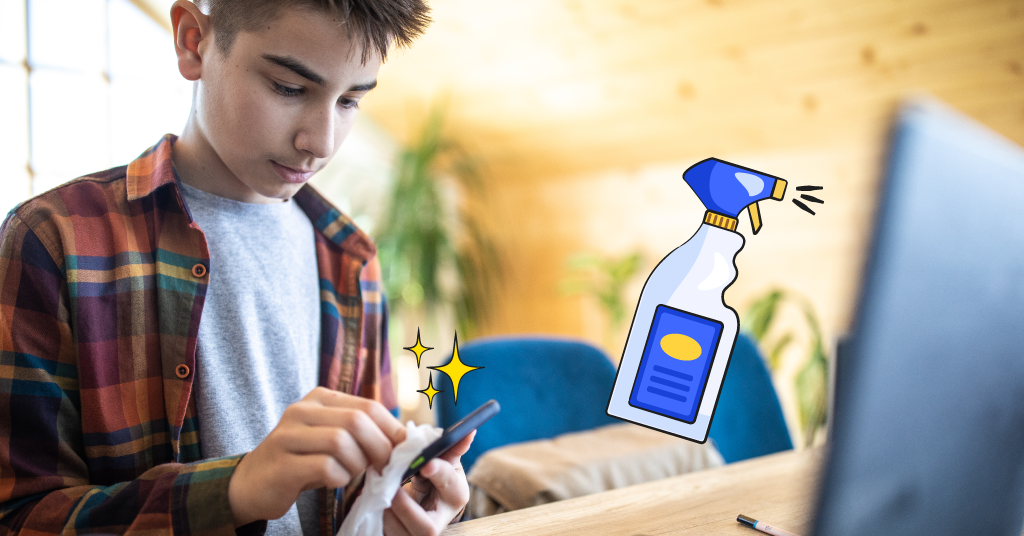
**Please note: This blog post was updated on September 12, 2024.**
VR (virtual reality) headsets are a relatively new mode of gaming, which can be equally intriguing and intimidating for parents. VR technology takes the 2-D world we’re used to on our phones and TVs and turns it into 3-D simulation. It’s certainly a unique way to game, but as with any new tech, it’s important to weigh the pros and cons.
Whether you’re considering a VR headset as a gift for your kids or you simply want more information about it, you’re in the right place! We did the research and put together the best (and worst) parts of VR gaming.
Pros
Introduces an interactive and unique gaming experience
There’s no doubt that VR experiences are cool. The first time you try it it feels like you jumped 100 years in the future. And it’s only going to get better and more advanced from here. For particularly game-savvy families, this is definitely a train you’re going to want to hop on!
Promotes physical activity
This is probably the best part about VR headsets, they get kids up and moving! No more slouching on the couch with a game controller. VR allows kids to play games that make them dance and jump around the living room. Looking for things to do in the winter with a particularly active kid? Try a VR game! Need an intriguing way to get a particularly non-active kid’s blood pumping? Try a VR game!
Improves hand-eye coordination
Video games in general are good for helping improve hand-eye coordination, but VR headsets take it to a whole new level! Knowing where your body is in space — even when you can’t see what’s really there — is a skill that can be improved upon with VR headsets.
Cons
Creates a high risk for inappropriate content
Now for the worst part about VR headsets: almost all of them come with a web browser. This should be a red flag for parents that there’s a high risk of their kid encountering inappropriate content. Note: One of the first industries to take advantage of the new VR tech was the porn industry.
Opens the door to predatory behavior
Sadly, we’ve seen many reports of predators using their avatars to groom and then sexually “assault” kids’ avatars in VR chat rooms. At Bark, we’re no stranger to the threat that chat rooms pose to kids online. However, VR chat rooms are an exceptionally dangerous and disturbing risk for kids, as it's experienced far more vividly than other online abuse.
Meta Quest is currently the top dog in the VR world and has some controls when it comes to preventing kids from interacting with strangers. For child accounts ages 10-12, parents have to approve contacts before their child can call or chat with them. However, it should noted that kids can still message unapproved users within specific apps that have messaging features.
While contact approval should be an adequate guardrail for most kids interacting on Meta's VR, this still opens the door to kids talking with strangers that Meta simply could've blocked altogether for this age group. Additionally, Meta does not give this same option for 13+ accounts, though parents can see who their teen is interacting with through their Supervision controls.
Impacts vision and causes potential motion sickness
The research on this is very preliminary and it's hard to say for sure how VR experiences can impact one’s vision. However, it’s not a far leap to assume it may not help your child’s developing brain. Our brains are not used to perceiving things “far in the distance” when in reality it’s only inches from our face. Some families may consider keeping a shorter time limit on their kid’s VR use to help mitigate any potential harmful effects.
Additionally, there are many anecdotal reports of those who easily feel motion sickness from using a VR headset even for a short amount of time. These reports come mostly from adults rather than kids. However, it’s a good idea to remind your kid to take notice of how they’re feeling physically while playing.
Pro tip: Most VR headsets have an “IPD adjustment” setting (IPD stands for interpupillary distance, which refers to the distance between your eyes). Adjusting the IPD on your headset to match your own IPD can help make the VR experience more visually accurate and therefore less likely to cause vision strain or motion sickness.
Our Tips
Monitor through TV or phone
The best way to ensure your child is playing safely is to keep an eye on their activity yourself. The good news is that most headsets allow you to cast the VR game to your TV or phone so you can see what your child is seeing through their headset.
Consider singleplayer games
One way to avoid unwanted behavior from strangers through VR is to have your child play single-player games. This way, you can have peace of mind that your child is purely gaming — not interacting with any potential bad actors.
Research parental controls
It’s important to always research the parental controls for any new tech or platform before your child interacts with it. Use the parental controls at your disposal and be sure to pair these controls with frequent talks with your child about online safety.
Seeing as Meta's VR headset — Meta Quest, formally Oculus — is currently the top dog in the VR space, we've included some information about their parental controls here.
Meta Quest parental controls for ages 10-12:
- The child's account must be set up and managed by a parent.
- Parents can set time limits.
- Meta automatically blocks ads.
- Meta only recommends games and apps appropriate for preteens.
- Parents must approve or deny app downloads.
- Parents must individually approve each user their child can interact with on Quest.
Meta Quest parental controls for ages 13 and older:
- Teens must initiate an invite to their parents to set up a Supervised account.
- Parents can set time limits.
- Meta only recommends games and apps appropriate for teens.
- Parents can be notified of the apps their teen buys or downloads.
- Parents can block individual apps in the Meta Quest Store.
- Parents can view who their teen is interacting with on Quest.
Use the Bark Home
Our last tip for parents is to consider using web filtering at the router level to keep their kids safe on VR headsets. And Bark has just the thing! The Bark Home is a small device that plugs into your router and filters all web traffic for internet-connected devices in the home. This includes tablets, computers, gaming consoles, smart TVs, and of course VR headsets. The Bark Home allows you to set screen time limits and block inappropriate sites and apps, either individually or by entire category. Learn more about how the Bark Home can help protect your kids on their home devices.
Read more
Bark helps families manage and protect their children’s digital lives.





